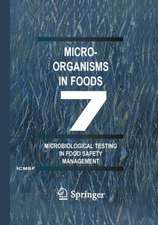Edible Films and Coatings: Fundamentals and Applications: Food Preservation Technology
Editat de Maria Pilar Montero Garcia, M. Carmen Gómez-Guillén, M. Elvira López-Caballero, Gustavo V. Barbosa-Cánovasen Limba Engleză Hardback – 24 aug 2016
Edible Films and Coatings: Fundamentals and Applications discusses the newest generation of edible films and coatings that are being especially designed to allow the incorporation and/or controlled release of specific additives by means of nanoencapsulation, layer-by-layer assembly, and other promising technologies. Covering the latest novelties in research conducted in the field of edible packaging, it considers state-of-the-art innovations in coatings and films; novel applications, particularly in the design of gourmet foods; new advances in the incorporation of bioactive compounds; and potential applications in agronomy, an as yet little explored area, which could provide considerable advances in the preservation and quality of foods in the field.
Preț: 1419.14 lei
Preț vechi: 1978.08 lei
-28% Nou
Puncte Express: 2129
Preț estimativ în valută:
271.59€ • 282.49$ • 224.21£
271.59€ • 282.49$ • 224.21£
Carte tipărită la comandă
Livrare economică 15-29 aprilie
Preluare comenzi: 021 569.72.76
Specificații
ISBN-13: 9781482218312
ISBN-10: 1482218313
Pagini: 616
Ilustrații: 88
Dimensiuni: 178 x 254 x 38 mm
Greutate: 1.27 kg
Ediția:1
Editura: CRC Press
Colecția CRC Press
Seria Food Preservation Technology
ISBN-10: 1482218313
Pagini: 616
Ilustrații: 88
Dimensiuni: 178 x 254 x 38 mm
Greutate: 1.27 kg
Ediția:1
Editura: CRC Press
Colecția CRC Press
Seria Food Preservation Technology
Public țintă
Professional ReferenceCuprins
Section I Preparation, Properties, and Characterization of Coatings and Films 1. Standard and New Processing Techniques Used in the Preparation of Films and Coatings at the Lab Modeling 3. Barrier Properties of Films Section II Traditional and Alternative Sources for Biopolymeric Film and Coating Matrices 4. Films and Coatings from Vegetable Protein 5. Films and Coatings from Animal Protein 6. Films and Coatings from Collagen and Gelatin7. Films and Coatings from Starch and Gums 8. Films and Coatings from Lignocellulosic Polymers 9. Films and Coatings from Chitosan 10. Films and Coatings from Lipids and Wax 11. Films and Coatings from Agro-Industrial Residues Section III Strategies to Optimize Coating and Film Functionality 12. Conventional and Alternative Plasticizers and Cross-Linkers 13. Nanocompounds as Formulating Aids 14. Antioxidant Films and Coatings 15. Antimicrobial Edible Films and Coatings Section IV Encapsulation and Controlled Release in Films and Coatings 16. Methods of Encapsulation17. Encapsulation of Flavors and Aromas: Controlled Release 18. Encapsulation of Active/Bioactive/Probiotic Agents Section V Applications of Films and Coatings in Foodstuffs 19. Application of Edible Films and Coatings on Fruits and Vegetables 20. Edible Film and Coating Applications for Fresh-Cut and Minimally Processed Fruits and Vegetables 21. Edible Packaging in Muscle Food 22. Applications of Films and Coatings in Intermediate Moisture and Thermally Processed Food 23. Applications of Films and Coatings for Special Missions Section VI Coatings and Films: Drawbacks and Challenges24. Films and Coatings: Migration of Ingredients25. Migration Analysis of Compounds in Food Packaging 26. Edible Films and Coatings: Sensory Aspects 27. Digestibility and Toxicology of Edible Films and Coatings 28. Biodegradable Polymer for Food Packaging: Degradation and Waste Management 29. Agricultural Applications of Biodegradable Films
Notă biografică
Gustavo V. Barbosa-Canovas Department of Biological Systems Engineering, Washington State University, Pullman, Washington. M. Carmen Gomez-Guillen, M. Elvira Lopez-Caballero and Maria Pilar Montero Garcia, all Department of Products, Institute of Food Science, Technology and Nutrition, Spanish National Research Council, Madrid, Spain.
Descriere
The search for better strategies to preserve foods with minimal changes during processing has been of great interest in recent decades. Traditionally, edible films and coatings have been used as a partial barrier to moisture, oxygen, and carbon dioxide through selective permeability to gases, as well as improving mechanical handling properties. This book covers the newest generation of edible films and coatings that are being especially designed to allow the incorporation and/or controlled release of specific additives by means of nanoencapsulation, layer-by-layer assembly, and other promising technologies.































